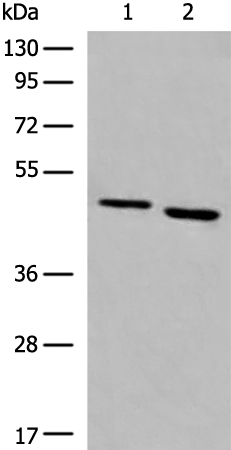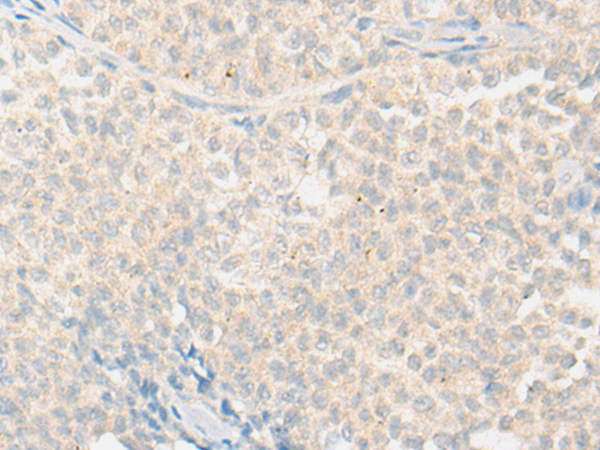

| WB | 咨询技术 | Human,Mouse,Rat |
| IF | 咨询技术 | Human,Mouse,Rat |
| IHC | 1/20-1/100 | Human,Mouse,Rat |
| ICC | 技术咨询 | Human,Mouse,Rat |
| FCM | 咨询技术 | Human,Mouse,Rat |
| Elisa | 1/5000-1/10000 | Human,Mouse,Rat |
| Aliases | EAR3; BBOAS; EAR-3; NR2F2; SVP44; BBSOAS; ERBAL3; TFCOUP1; COUP-TFI; TCFCOUP1 |
| WB Predicted band size | 46 kDa |
| Host/Isotype | Rabbit IgG |
| Antibody Type | Primary antibody |
| Storage | Store at 4°C short term. Aliquot and store at -20°C long term. Avoid freeze/thaw cycles. |
| Species Reactivity | Human, Mouse |
| Immunogen | Synthetic peptide of human NR2F1 |
| Formulation | Purified antibody in PBS with 0.05% sodium azide and 50% glycerol. |
+ +
以下是3篇关于NR2F1抗体的相关文献摘要概括:
1. **"NR2F1 regulates neural progenitor cell proliferation and differentiation"**
- 作者:Bertacchi M et al. (2020)
- 摘要:研究利用NR2F1特异性抗体进行免疫染色,揭示该转录因子在小鼠皮层发育中通过调控Notch信号通路影响神经前体细胞的增殖与分化。
2. **"COUP-TFI/NR2F1 antibody validation in glioblastoma models"**
- 作者:García-Domínguez DJ et al. (2018)
- 摘要:通过Western blot和免疫组化验证NR2F1抗体的特异性,发现其在胶质母细胞瘤中异常高表达,并与肿瘤干性维持相关。
3. **"NR2F1 in human pluripotent stem cell differentiation"**
- 作者:Liu Y et al. (2016)
- 摘要:使用ChIP-seq结合NR2F1抗体,证明其在人胚胎干细胞向神经外胚层分化过程中通过抑制Wnt通路关键基因发挥作用。
注:以上文献信息为基于领域研究的概括性描述,实际引用需核对具体论文原文。
The nuclear receptor subfamily 2 group F member 1 (NR2F1), also known as COUP-TFI (Chicken Ovalbumin Upstream Promoter Transcription Factor I), is a transcription factor belonging to the steroid/thyroid hormone receptor superfamily. It plays critical roles in embryonic development, cellular differentiation, and organogenesis, particularly in the nervous system, eye development, and cardiovascular formation. NR2F1 regulates gene expression by binding to specific DNA response elements, either as a monomer, homodimer, or heterodimer with other nuclear receptors. It is involved in maintaining stem cell pluripotency, neuronal patterning, and angiogenesis. Dysregulation of NR2F1 has been linked to developmental disorders (e.g., Bosch-Boonstra-Schaaf optic atrophy syndrome), cancer progression (acting as either an oncogene or tumor suppressor depending on context), and neurological conditions.
NR2F1 antibodies are essential tools for studying its expression, localization, and molecular interactions. They are widely used in techniques like Western blotting, immunohistochemistry, immunofluorescence, and chromatin immunoprecipitation (ChIP). These antibodies are typically developed against specific epitopes of the NR2F1 protein, with validation including knockout controls, species cross-reactivity checks, and functional assays. Both monoclonal and polyclonal variants are available, with host species ranging from rabbit and mouse to goat. Researchers must verify antibody specificity for their experimental models, as cross-reactivity with homologous proteins (e.g., NR2F2/COUP-TFII) may occur. Commercial NR2F1 antibodies often include validated application-specific data, supporting their use in developmental biology, cancer research, and neurological studies.
×